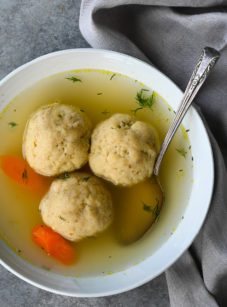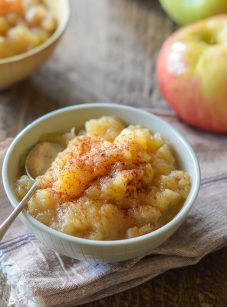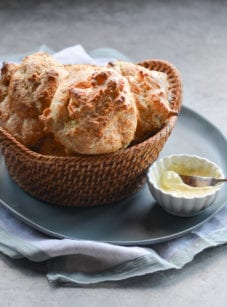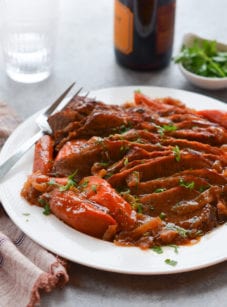Charoset (A Sweet Apple and Nut Mixture for Passover)
- By Jennifer Segal
- March 31, 2025
- Leave a Review


This post may contain affiliate links. Read my full disclosure policy.
This charoset recipe is sweet, crunchy, and steeped in tradition—one of those Passover dishes families look forward to all year, and once you taste it, you’ll understand why.

Charoset (pronounced ha-ROH-set) is a sweet, symbolic Passover dish that represents the mortar used by the Israelites during their enslavement in Egypt. This Ashkenazi recipe—passed down from my dear friend Dana Kaminsky’s “Grama Rose”—is made with apples, nuts, sweet red wine, orange juice, and just a hint of honey and cinnamon.
Unlike the thick, paste-like Sephardic version made with dates and figs, this charoset is bright, crunchy, and refreshing.
Traditionally, charoset is served on the Seder plate, enjoyed on its own, or paired with matzo. Many people love to scoop it onto matzo with maror (bitter herbs, often represented by horseradish) to make a symbolic sandwich—blending the bitterness of the herbs with the sweetness of the charoset as a reminder of both hardship and hope.
What you’ll Need To Make Charoset

- Apples – The crisp, juicy base of the charoset. Use a tart-sweet varietal, like Honey crisp, Granny Smith, Fuji, or Gala (a blend works well too).
- Nuts – Add texture, richness, and a little crunch in every bite. A combination of almonds and walnuts is ideal.
- Sweet red wine or grape juice – Adds moisture and sweetness (I like to use Manischewitz for that classic Passover flavor).
- Orange juice – Brightens things up and balances the sweetness.
- Honey and sugar – Sweetens the charoset and brings the flavors together.
- Salt – Just a bit rounds out the flavors.
- Cinnamon – Adds warmth and flavor.
- Jump to the printable recipe for precise measurements
Step-By-Step Instructions For Making Charoset
In a medium bowl, add the apples, walnuts, almonds, wine, orange juice, honey, sugar, salt, and cinnamon.

Give everything a good toss until it’s well mixed, then taste and adjust the seasoning if needed. Let it sit for at least 30 minutes so the flavors can mingle—or pop it in the fridge for a few hours if you’re making it ahead.

Serve charoset chilled or at room temperature, on its own, or as part of the Seder plate. If you have leftovers, it’s wonderful over cottage cheese or yogurt, spooned onto matzo with a little butter or cream cheese, or simply enjoyed by the spoonful straight from the fridge.

Charoset

Ingredients
- 3 large tart-sweet apples (Granny Smith, Honey Crisp, Fuji, or Gala work well), peeled, cored, and chopped into ¼-inch pieces
- 1 cup walnuts, chopped
- 1 cup slivered almonds, chopped
- ¼ cup sweet red wine (such as Manischewitz) or grape juice
- ¼ cup orange juice, from 1 orange (or store-bought)
- 2 tablespoons honey
- 1 tablespoon sugar
- ¼ teaspoon salt
- ¼ teaspoon cinnamon
Instructions
- In a medium bowl, combine the apples, walnuts, almonds, wine, orange juice, honey, sugar, salt, and cinnamon. Taste and adjust seasoning, if needed. Let the charoset sit for at least 30 minutes to allow the flavors to meld, or refrigerate it for a few hours if making ahead.
- Serve chilled or at room temperature, either on its own or as part of the Seder plate.
Notes
Nutrition Information
This website is written and produced for informational purposes only. I am not a certified nutritionist and the nutritional data on this site has not been evaluated or approved by a nutritionist or the Food and Drug Administration. Nutritional information is offered as a courtesy and should not be construed as a guarantee. The data is calculated through an online nutritional calculator, Edamam.com. Although I do my best to provide accurate nutritional information, these figures should be considered estimates only. Varying factors such as product types or brands purchased, natural fluctuations in fresh produce, and the way ingredients are processed change the effective nutritional information in any given recipe. Furthermore, different online calculators provide different results depending on their own nutrition fact sources and algorithms. To obtain the most accurate nutritional information in a given recipe, you should calculate the nutritional information with the actual ingredients used in your recipe, using your preferred nutrition calculator.
Gluten-Free Adaptable Note
To the best of my knowledge, all of the ingredients used in this recipe are gluten-free or widely available in gluten-free versions. There is hidden gluten in many foods; if you're following a gluten-free diet or cooking for someone with gluten allergies, always read the labels of your ingredients to verify that they are gluten-free.
See more recipes:
This site uses Akismet to reduce spam. Learn how your comment data is processed.




Add a Comment